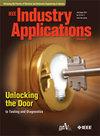Synthesis of Low-Voltage Minimum Switch-Count DC Bus Second-Harmonic Hybrid Filters
IF 4.2
2区 工程技术
Q2 ENGINEERING, ELECTRICAL & ELECTRONIC
引用次数: 0
Abstract
Active Power Decoupling (APD) has emerged as an attractive technique to eliminate large DC bus filter capacitors in single-phase power conversion. For space-constrained circuits with reliable operation, DC capacitor elimination is an advantage as long as the added component count, rating, and control complexities do not outweigh the benefits. The present work focuses on adding a minimum number of active components of low voltage ratings to alleviate bulk DC bus filter capacitors from single-phase power converters. Thus, the driving circuits and control efforts also get proportionally scaled down while yielding the benefits of bulk capacitor reduction. Apart from the minimum component count, the use of low-voltage devices ensures reduced switching and conduction losses, improving the active filter efficiency. A generalized topology synthesis framework is presented that yields a family of low voltage, minimum switch-count APD filter derivatives with identical operational objectives. The control and operational trade-offs of the derived filter topologies are compared and a design-oriented ripple analysis is performed to maximize capacitor utilization. The significant attributes of the derived filters are compared with the state-of-the-art active and hybrid filters. The operations of the synthesized three unique topologies are experimentally validated using laboratory hardware at a 500 W power level. Above 90% reduction in the DC bus second-harmonic ripple is achieved by the action of the proposed filters. With the proposed control, the boost-based SC-BOHF topology exhibits better filtering performance than SC-BUHF and SC-BBHF.低压最小开关计数直流母线二次谐波混合滤波器的合成
有功功率去耦(APD)作为消除单相电源转换中大型直流母线滤波电容器的一种有吸引力的技术而出现。对于具有可靠运行的空间受限电路,只要增加的元件数量、额定值和控制复杂性不超过其好处,消除直流电容就是一种优势。目前的工作重点是增加最小数量的低额定电压有源元件,以减轻单相电源变换器的大量直流母线滤波电容器。因此,驱动电路和控制工作也按比例缩小,同时产生体积电容器减少的好处。除了最小的元件数量,低压器件的使用确保减少开关和传导损耗,提高有源滤波器的效率。提出了一种广义拓扑综合框架,该框架产生了一系列具有相同工作目标的低电压,最小开关计数APD滤波器衍生物。对衍生滤波器拓扑的控制和操作权衡进行了比较,并进行了面向设计的纹波分析,以最大限度地提高电容器利用率。将衍生滤波器的重要属性与最先进的有源滤波器和混合滤波器进行了比较。利用实验室硬件在500 W功率水平下对合成的三种独特拓扑的操作进行了实验验证。通过所提出的滤波器的作用,直流母线二次谐波纹波降低了90%以上。在此控制下,基于升压的SC-BOHF拓扑比SC-BUHF和SC-BBHF具有更好的滤波性能。
本文章由计算机程序翻译,如有差异,请以英文原文为准。
求助全文
约1分钟内获得全文
求助全文
来源期刊

IEEE Transactions on Industry Applications
工程技术-工程:电子与电气
CiteScore
9.90
自引率
9.10%
发文量
747
审稿时长
3.3 months
期刊介绍:
The scope of the IEEE Transactions on Industry Applications includes all scope items of the IEEE Industry Applications Society, that is, the advancement of the theory and practice of electrical and electronic engineering in the development, design, manufacture, and application of electrical systems, apparatus, devices, and controls to the processes and equipment of industry and commerce; the promotion of safe, reliable, and economic installations; industry leadership in energy conservation and environmental, health, and safety issues; the creation of voluntary engineering standards and recommended practices; and the professional development of its membership.
 求助内容:
求助内容: 应助结果提醒方式:
应助结果提醒方式:


